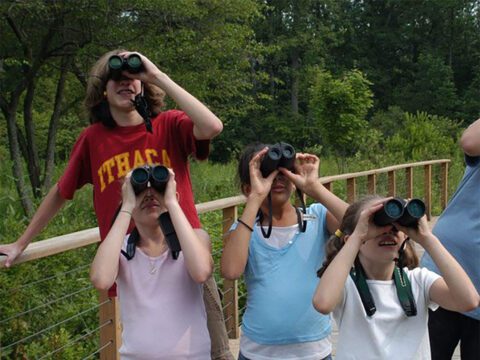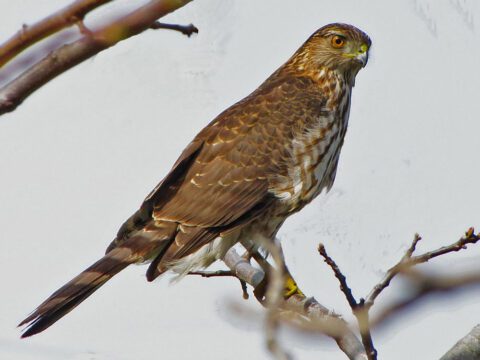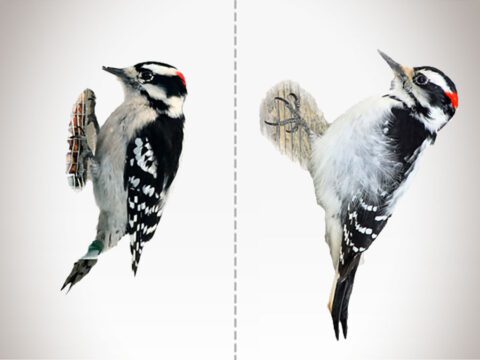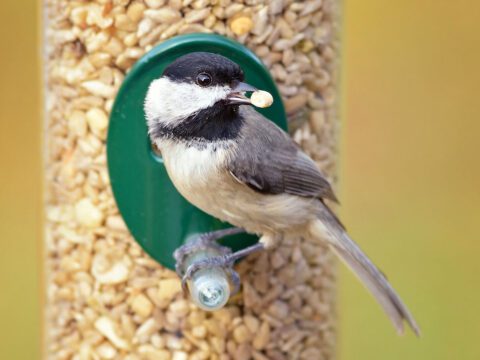The Basics: How Birds Navigate When They Migrate
April 1, 2008
Staying On Course
Birds have a remarkable homing instinct, allowing them to return to the same area year after year, even when their migration takes them halfway around the world. How this remarkable feat is accomplished has been the topic of many studies.
Young birds
Research indicates that young birds that do not migrate with their parents have an innate knowledge of the direction and distance they should travel, but lack a specific goal. After it arrives at its wintering grounds, the young bird will select a winter range to which it imprints during that winter. After the first year the bird has the ability to return to the same area, even if blown off course during migration.
Adult birds
Adults seem to have even more homing skills. Two classic experiments illustrate this point.
Manx Shearwaters were flown by plane from their nesting island off the coast of Great Britain to two different locations. One group was released near Boston, MA, and another near Venice, Italy. Shearwaters do not fly over land so both groups must have taken an over water route, which would be especially convoluted from Venice. Both groups of birds returned to their nesting burrows within 14 days, covering approximately 250 miles per day. How they were able to achieve this remarkable return is not fully understood.
In another experiment, several hundred White-crowned Sparrows were captured in their winter grounds near San Jose, California. One group was flown to Baton Rouge, Louisiana, and released, while a second group was flown to Laurel, Maryland, and released. The following winter thirty-four of the birds were recaptured in the same 1/4 acre plot in California they had been captured in originally, presumably after having visited their northern breeding grounds during the summer.
Homing Pigeon Studies
Homing pigeons have been used extensively as test subjects in order to develop a better understanding of migration and homing abilities. They have exhibited almost unbelievable navigation skills.
In one noted experiment, German scientist Hans Wallraff transported homing pigeons to a very distant location. To ensure that the birds did not receive any external navigational information, they were transferred under stringent conditions. The pigeons were transported in closed, airtight cylinders and provided bottled air. Light was turned on and off at random times and loud white noise was played. The cylinders were enclosed in magnetic coils that provided a changing magnetic field. Finally, the cylinders were mounted on a tilting turntable connected to a computer that varied both the rotation and tilt of the cylinders. After release at the distant and completely unknown area, the birds were able to fly home to their roost, apparently without trouble (other than an initial case of nausea).
The pigeons’ ability to fly home from a totally strange and distant location indicates that somehow the birds have both an internal compass and an internal map. A compass by itself would not be helpful, since the bird would not know if it were north, south, east or west of its home. The question of how a bird has a map of a location to which it has never been before (and was transferred to under such isolated conditions in the above test) and the sense of the direction it must take to return home remains a puzzle. Some possible explanations have been proposed, as follows:
Internal Maps
The nose knows theory
How could a bird possibly have a map of places it has never been? One very surprising theory suggests that homing pigeons may use an olfactory map.
Visualize a pigeon in its home loft with the smell of pine trees from one direction and the smell of an onion farm in another. If the bird moves closer to the pine trees, the odor of pine will presumably grow stronger while the odor of onions grows weaker. In theory, a gradient map of odors could be created that would provide some directional information, even if the pigeon were suddenly dropped into a new location. Floriano Papi and others from the University of Pisa initiated this theory and have some evidence that olfactory navigation may extend to a distance of 310 miles. This theory remains controversial.
Magnetic map theory
A second theory suggests that birds use the earth’s magnetic field to obtain at least a partial map of its position. The earth’s magnetic field becomes stronger as you travel away from the equator and toward the poles. In theory, a bird might be able to estimate its latitude based on the strength of the magnetic field. While the change in strength is very small from one location to the next, there is some indication that homing pigeons have the sensitivity to detect even tiny changes in the strength of the magnetic field. Even if true, this would provide only a limited indication of the bird’s latitude.
At this time there is no clear evidence that either of these theories is the complete story and the mapping skills of birds remains largely unexplained.
The Compass
The other half of the navigation requirement is the compass. The internal map provides a bird with the general location of where it is relative to its homing or migration goal and its internal compass guides its flight and keeps it on course. Migrating birds are apparently utilizing several different compasses.

The sun compass
In 1951 Gustav Kramer discovered the sun compass. He performed his experiments by placing European Starlings in orientation cages and then used mirrors to shift the apparent location of the sun. In response, the birds shifted their migratory restlessness to match the compass direction indicated by the apparent new position of the sun.
Further research revealed that the bird’s sun compass is tied to its circadian rhythm. It seems birds have a time compensation ability to make allowances for changes in the sun’s position over the course of the day. This theory is supported by another experiment in which pigeons were placed in a closed room with an altered cycle of light and dark. Over a period of a few days their circadian rhythm was reset. The birds were then released on a sunny day. Because their “internal clock” had been reset, they misinterpreted the position of the sun and made a predictable error in their homing direction. The pigeons actually ignore the position of the sun relative to its position in the sky, relying on its azimuth direction, i.e. the compass direction at which a vertical line from the sun intersects the horizon.
Further study has also revealed that pigeons have to learn the sun’s path to use it in navigation. Young pigeons allowed to see the sun only in the morning lack the ability to use the sun for navigation in the afternoon.
The star compass
The sun compass plays a role in homing and may be used by birds that migrate during the day. Many songbird species, however, migrate at night. For many years scientist suspected that birds use the stars for navigation. In 1957 Franz and Eleanor Saur collected data from a series of experiments in which birds were placed inside an enclosed planetary dome. The Saurs were able to demonstrate that birds do use the stars for migration but not, as it turns out, in the way they thought. The common belief at the conclusion of the Saur experiments was that birds have a genetically coded map of the stars. In 1967 Cornell scientist Stephen Emlen used Indigo Buntings to prove that the actual story was a little different.
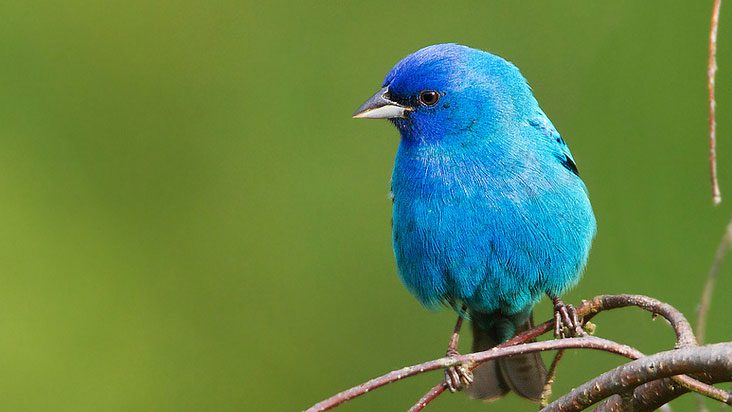
Dr. Emlen also used a closed planetarium for his tests. He started by collecting young birds and then hand raising them in a lab. His research included the following:
A. One group of birds was raised in a windowless room and was never exposed to a point source of light.
B. A second group also never saw the sun but was exposed on alternate nights to a simulated night sky in the planetarium, with normal rotation around the North Star.
C. A third group was also raised in a windowless room, but on alternate nights was exposed to a simulated night sky in the planetarium. In this case, the sky was manipulated to rotate about a different star, Betelgeuse.
When the fall migration period started, the birds were released into a special cage inside the planetarium.
Group A was placed in the planetarium under a normal fixed sky. The birds oriented themselves in random directions, showing no ability to recognize a southerly migration direction.
Group B was placed in the planetarium with a normal rotation around the North Star. The birds oriented themselves away from the North Star, in the appropriate southern direction for migration.
Group C was also placed into the planetarium. They had been raised with Betelgeuse as the central point of rotation. When exposed to a normal sky these birds oriented themselves away from Betelgeuse.
This research indicates that young birds do not learn star patterns themselves but learn a north-south orientation from a rotational star pattern.
The Magnetic Compass
Another German team did research with the European Robin in the early 1960s. In their tests, robins showing migratory restlessness were placed in covered cages to eliminate sun, star and other light clues. Despite the lack of visual clues, the robins were observed hopping in the correct migratory direction.
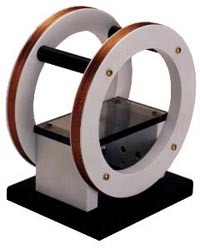
As an additional refinement to the test, a Helmholtz coil was placed around the covered cages. The coil allowed the researchers to shift the direction of the earth’s magnetic field. When the direction of the magnetic field was changed, the robins changed their hopping direction.
Further research indicates that while birds can sense the north and south ends of a compass, they cannot tell the difference between the two. To determine which direction is north, the birds apparently have the capability to sense that the magnetic lines of force align toward the poles of the earth. They can also detect the dip in the lines of force as they approach the earth and, through some currently unknown method, seem to be able to detect and make navigational decisions based on the dip angle.
The Sunset Cue
Patterns of polarized light also appear to play a key role in navigation. Many of the nocturnal migrants start their flights at sunset or a little after. Birds apparently use the polarized light patterns to provide information on initial migratory flight directions.
Landmarks
Birds that migrate during the day often follow, and may recognize, natural landforms such as mountain ranges, rivers, and lakes.
There is some indication that birds use multiple compass methods and calibrate them against each other. Some species use one type of compass as the primary navigational aid while others rely on a different primary system. The complexity of migration and the skill with which it is accomplished is one of the many marvels that make birds so interesting to study.

All About Birds
is a free resource
Available for everyone,
funded by donors like you
American Kestrel by Blair Dudeck / Macaulay Library

